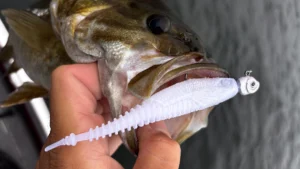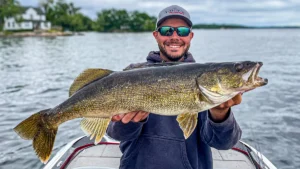If you talk to catfish fishermen across the country, they’ll tell you about all of the different types of natural and unnatural things they use to catch fish in rivers, reservoirs and ponds. Catfish baits are as varied as the species themselves and the waters they inhabit; certain items perform better than others in a given scenario. To figure out what bait you should use, you need to understand the habits of each species, and how they behave in different environments.
Species-Specific Bait Preferences
It’s easy to think of all them all as just “catfish,” but each species has their own preferences when it comes to eating. And, they behave differently in different types of water bodies. Examining where they live and what they eat can help put more cats on the bank or in the boat. Let’s take a closer look at each.
CHANNEL CATFISH
Channel catfish are widespread. You can find them from the Red River on the Minnesota-Manitoba border to the other Red River, the one that flows through southern Louisiana. Their range also stretches from coast to coast. Healthy populations exist in California’s Sacramento River and all the way across to the Connecticut River in New England. You can expect fish to 30 pounds just about wherever they swim.
In these varied locations, they eat different species of fish both alive or dead. Their diet also includes other materials, like snails, insect larvae, crustaceans, and vegetable matter. Channel catfish are what fish biologists call “omnivores;” ready to eat whatever fits in their mouth. They can derive protein from the strangest meals.
Channel catfish rely more on their sense of small and follow their nose to cut bait or other tasty formulas. Moreover, their acute sense of smell allows them to follow a scent trail for a long distance, tracking down the source and eating anything they consider edible. This makes it easy for anglers to choose a good bait. Whatever fish are used to eating in that waterway will work well, and the more flavorful the better.
BLUE CATFISH
Blue catfish are their bigger cousins and differ somewhat in their habits. Originally a resident of the largest rivers of the central U.S., they’ve been introduced to the East and West Coasts. Now, blues thrive in reservoirs and tidal rivers alike. Where they live, and the forage present, plays a big role in bait selection.
Powerful predators, blues follow schools of baitfish in deep reservoirs and feed at will as they grow well past 100 pounds. In some cases, they share habitat with striped bass as they also favor pelagic prey fish that roam offshore. Blues feed on the abundant baitfish in the reservoir: gizzard and threadfin shad, blueback and skipjack herring are favorites. Asian carp, silver and bighead, have invaded waters near and far, following their release in Arkansas, and have become an important food.
In smaller reservoirs where they’ve been stocked, blues don’t grow as large and behave more like channel catfish, feeding on bottom for anything they can find. Blue cats eat lots of zebra mussel in waters infested with them, making mollusks a viable bait. In tidal rivers, anglers often target blues by chumming with ground bait .
FLATHEAD CATFISH
Flatheads aren’t closely related to the other two major catfish species and their behavior is very different. They’re originally a fish of medium-size and larger rivers of the Central states, from Iowa east to Alabama and west to Texas. Flatheads have also been introduced widely. Now found in several southwestern states and California, where the extensive irrigation systems there have allowed them to colonize new waters. On the East Coast, stocked fish have spread into rivers from Maryland to Florida.
Their sense of smell, along with their taste buds, help flathead catfish locate food, even at night in the murkiest river. They particularly thrive in rivers, as current washes the smell of prey downstream and lead catfish to their prey. But they’ve adapted well to ponds and impounded waters as well. It seems like no water is off limits for the flathead.
Overall, flatheads seem to prefer large baitfish, while smaller ones (under 10 pounds) eat invertebrates and small fish. Invertebrates such as worms, insects and crayfish can be good baits for smaller flatheads. Of all the catfish species, flatheads are most noted for preferring live bait over cut chunks. They’re solitary hunters that prowl at night, looking for big prey such as bluegills and green sunfish, small carp, bullheads, suckers, and smaller catfish of any kind. Setting a big live bait near a dense snag is a favorite technique wherever flatheads roam.

NATURAL CATFISH BAITS
Catfish eat many types of prey that can be found in their waterways. This includes live and dead fish, as well as invertebrates such as insects, mollusks, crayfish and worms. At times, these opportunistic predators will even even consume amphibians, reptiles, even birds and small mammals. Obviously, some of these make better baits than others. Here’s what has worked for me.
GIZZARD SHAD
You can’t go wrong with prey fish that live in the lake, river, or reservoir you’re fishing. Across the Midwest and South, gizzard shad are an almost universal baitfish that bass, crappies, and walleyes also key in on. They range deep and shallow, commonly reaching 14 inches and a pound—a good meal for a lunker cat. In the milder waters of southern states, they’re joined by the closely related threadfin shad that generally run from 3 to 6 inches.
Catching shad with a cast or dip net often is the first step to a successful day on the river. Ice them down in a cooler and cut them into chunks or toss them in the livewell and fish them alive. Live bait makes a livelier offering, putting out vibrations that can attract cats. But nothing tops the flavors that spill out of a cut chunk, along with blood and guts. Cats aren’t picky and will eat the head and tail pieces along with prime back straps.
SUCKERS
Other top baitfish include suckers, which are common prey in the northern rivers where shad aren’t found. Many species of red horse, as well as the common white sucker, make great baits. Their flesh is quite solid and stays on the hook well. Suckers can be caught with a piece of worm or seined up. Bait shops sell them if you can’t find them. These are most often used as chunks, but you can fish them live.
ANADROMOUS SPECIES
On the East Coast, catfish eat the anadromous herrings and shad that make a run up creeks in spring. Blueback herring, hickory and American shad and alewives follow this pattern. Skipjack herring are also an important bait, but remain in the freshwater sections of big rivers. Several of these species, most notably skipjack and blueback herring and alewives have been stocked or made their way into reservoirs, where they can complete their life history in fresh water. They make prime catfish baits, with skipjacks favored by many fishing guides who specialize in blue catfish. These species can be easily caught on jigs and light tackle in tailrace areas, particularly in spring. They can be frozen and used for months.
GOLDEYE AND MOONEYE
On the famous Red River of the North on the Minnesota-North Dakota border and running into Manitoba, where channel catfish often grow over 20 pounds, a baitfish called the goldeye is a local favorite. Easily recognized by their silver compressed body shape and their large, gold eyes; these 9- to 12-inch forage fish make a can’t-miss catfish bait. The closely related mooneye is another favorite in northern and central waters as well. Like the skipjack, they’re easily caught on small jigs. Liveline these whenever possible.
SUNFISH
In small impoundments and ponds that dot the countryside, catfish consume a lot of sunfish and small crappies as well. In a few states, it’s illegal to use them as bait since they’re classified as gamefish. But in many areas, they may be caught and used alive or dead. A live, legal-sized sunfish has accounted for many a giant cat. So give them a shot if the practice is allowed in your neck of the woods.
ASIAN CARP
Over the last 20 years, our waters have been invaded by Asian carp. Several species escaped from hatcheries made their way east and north, swimming up all major rivers. The silver and bighead carp are the most common, with bigheads reaching almost 100 pounds on a diet of plankton; silvers commonly from 10 to 15 pounds. Grass carp and black carp are fortunately less common. Catfish have learned that smaller carp make a great meal and are easy to find, as these invasive fish have limited the abundance of gizzard shad in some reservoirs. Cut Asian carp account for some of the biggest catfish caught each year.
COASTAL BAITFISH
Even unfamiliar fish can work, too, such as mackerel and anchovies that are available in Atlantic Coast bait shops. Those that are cured with salt and frozen are best, as their flesh is soft and easily flies off the hook if uncured. But their strong odor and oily flesh make them a favorite where available. Try these out, particularly in tidal rivers.

INVERTEBRATES FOR CATFISH BAIT
Invertebrates can make up a large portion of a catfish’s diet. Of course, this depends on the species of cat, and where it is in its lifecycle. The waterway they inhabit also plays a role. But wherever you fish, you should consider some of the following baits.
CRAYFISH
As frequent bottom dwellers, catfish encounter crayfish and gobble them eagerly. Flatheads, in particular, thrive on them until they reach 10 pounds or so, when they switch to larger fish. Craws make a fine bait in creeks where they can be caught by hand and hooked through the tail. Other creek critters like hellgrammites make fine baits, too.
WORMS
Catfish don’t often encounter earthworms in nature, but that doesn’t stop even the biggest channel cats from gobbling them up. Indeed, a worm’s flavor attracts nearly all freshwater gamefish, for unknown reasons. Nightcrawlers can be found on wet lawns at night or plucked from leaf piles, so anglers never need to be without bait. When heavy rains arrive, they often wash from lawns and parks into the street where they live until the sun bakes them out. Grab a flashlight and fill a can. If that fails, fast-food stores usually carry them. For lunker cats, gob three or four juicy ones on a 2/0 hook. For smaller “fiddler cats,” partially threading a ‘crawler on a No. 1 hook works fine.
Far less common but no less effective are catalpa worms, also known as “horn worms” for the fleshy bumps on their tail. They emerge on catalpa trees in mid-summer, often found on the bottom side of the leaves where they’re easy to grab. These trees are most common in the central U.S, from Illinois and Indiana south to Tennessee and Arkansas. Fish these on an appropriately-sized baitholder hook and hang on.
INSECTS
Another favorite in small creeks are grasshoppers that buzz around fields in summer, often falling into the water. They can be easily collected by hand or with a small-mesh net, particularly in early morning when they less active. They float and a couple on an unweighted hook makes topwater fishing for catfish a reality; a super-fun activity on a summer afternoon! Crickets work, too. Hooking them underneath the “collar” behind the head helps keep them on the hook.
MOLLUSKS
Freshwater mussels, such as zebra and quagga, and other mollusks like Asian clams also make good baits. Blue catfish are noted for eating loads of zebras, as you can sometimes hear the shells rattling in the gut of a big one. Their powerful jaws can crush shells, but breaking the shell and using the meat for bait offers the catfish a special treat without all the work of crushing and evacuation of shells, which must be gnarly, given the swollen anal vents of some big blue cats! Note that some states have regulations against using zebra and quagga mussels as bait, even in waters where they’re presently found.

UNNATURAL CATFISH BAITS
Though the following items are not found in nature, their appeal to catfish is undeniable. We don’t know who the first person to soak a chicken liver in pursuit of catfish was, but it worked and scores of others have followed in their foot steps. Here are some of the best baits you can find at the grocery store.
CHICKEN LIVER
Although chickens are rarely found in the stomachs of catfish, their livers make an effective and popular bait for channel catfish. Meat-packing companies sell livers or you can get them from a butcher if you aren’t among the growing number of people who raise their own! Some companies offer jarred livers, such as Rusty’s Bait in Kansas.
Livers are thin and delicate, so they readily break up in fast currents. You may need to rebait the hook every 10 minutes or so, especially if you continue making casts, which can pull it off the hook. But that’s not all bad, since the lost bait drifts downstream and can attract more fish to your hole. To hold them on the hook better, wrap in gauze or netting (cut up pieces of pantyhose works well). Form it into a golfball-size clump. The netting makes it easy to run the hook through.
CHICKEN BLOOD
Blood is another regional bait; usually chicken blood that’s been congealed. Anglers around Kansas and Oklahoma have traditionally used it for channel cats in slow creeks and reservoirs. They wrap a glob around a #4 or #2 treble hook and cast into likely spots, with a small weight. Blood is harder to obtain today due to FDA food-safety regulations, so it’s become more of a novelty bait.
HOTDOGS
Hotdogs are readily available and work well, too. Cut them into chunks to match hook size and fish them in creeks and reservoirs. While they’re easy to get, experts generally prefer more exotic mixtures that release more flavors. But catfish can even be fooled by a piece of soap, as it slowly dissolves and gives off a scent trail. These fish are far from connoisseurs!

MAN-MADE CATFISH BAITS
With their acute sense of smell and open-minded palate, catfish are very vulnerable to an incredible array of artificial baits. Tournament pros have been honing some of these recipes for years, dialing in the right combo of taste, smell, and texture to get bites. The most popular artificially-produced catfish baits including the following:
- dip baits
- punch bait
- dough baits
Many people label them all “stink baits” for obvious reasons. But there are substantial differences in their formulation and use. In any case, keep them in the garage or outside storage that’s safe from varmints, as the scent has a way of creeping out of a sealed jar. Gagging is common among novice anglers! Nonetheless, there are hundreds of makers of prepared baits in the U.S. Some are garage operations that jar their secret mix for local bait shops. Others, like Catfish Charlie, Magic Bait, and Cat Tracker measure their monthly production in tons.
DIP BAITS
This category is probably the most common form of “stink bait,” with sales strong across the catfish belt of the Midwest and Central regions. These specially-flavored mixtures have been perfected in the garage “labs” of bait makers for 100 years, testing it on local creeks and ponds.
Over the last 20 years, their use has gone viral, with dippin’ fans from the Carolinas to California. The inventors tend to be very secretive about their formulas, fearing rip-offs by some newcomer to the market. They’re a favorite for summer fishing, when catfish are most active and feeding heavily. The warm water also helps wash their potent formulas to nearby fish, bringing them to the baited hook. But some anglers fish it from early spring into winter.
Major catfish companies like Team Catfish, Cat Tracker, Uncle Josh, and Mr. Whiskers have promoted and distributed products nationally, as does Berkley, which has become a major player in catfish baits. Common ingredients include chicken livers and blood, rotten baitfish, cheese mixtures, shrimp, ground-up crayfish, and more. Often they’re allowed to more or less ferment to liquify and gain potency.
Popular dip bait options include the following:
- Team Catfish Super 7 Premium Dip Bait
- Catfish Charlie Extra Sticky Dip Bait
- Bill Dance Advantage Dip Bait
Fishing these baits requires use of some sort of carrier, such as a dip worm; sort of a short, ribbed plastic worm that’s hollow in the middle. Sponge-style holders also work well, as do the ones made from surgical tubing with holes cut in the sides. Many dip worms are sold pre-rigged with a hook on a leader, which can be clipped onto a snap swivel and fished with a slip sinker.
Many come tied with treble hooks, but more companies are using circle hooks to avoid hooking catfish deep in the gullet, which can kill them. But even if you’re harvesting your fish, removing the hook on a gut-hooked fish can take several minutes. Since they keep pulling on a baited hook and hooksets are rarely needed, catfish are easily hooked on circle hooks.
Push the carrier into the jar with a stick or other object to avoid getting the stuff on your fingers or clothes–particularly if you have any social plans in the near future! Another key is to make sure the dip worm is dry before sticking it back in the jar. Otherwise, drops of water from each time you rebait eventually turn the mix to thin and runny. Keep a towel for that purpose nearby.
PUNCH BAITS
Punch baits have been a favorite, especially in southern waters where anglers deal with very warm water. They’re simple to use and stay on the hook well without the use of dip worms or sponges used to hold dip baits.
Increased promotion of punch baits like the following have encouraged increased popularity of this bait type:
- Danny King’s Catfish Bait
- Team Catfish Sudden Impact Fiber Bait
- Magic Bait Stick It Punch Bait
- CJ’s Punch Bait
- Rippin’ Lips baits
- Little Stinker Punch Baits
Punch baits are based on all sorts of attractive stuff, such as congealed blood, soured cheese, shad guts, mashed crawdads, as well as garlic and fruity flavors. They work well in moving water, or in reservoirs and ponds. Guides love them for their simplicity, ease of use, and effectiveness. But, they tend to catch lots of eating-size fish, rather than the lunker cats that usually go for larger baits.
Push a No. 8 to No. 2 treble hook into a tub of punch bait with a stick until it’s buried above the hook eye, then pull it out at an angle. The bait adheres to the hook and catches on the barbs. It is thicker than dip bait so it doesn’t drip on your boat or clothes, which is a major plus! But at the same time, it’s not as quick to disperse in the water, so you need patience to let it soak and attract catfish to it. Fish them on bottom rigs with an egg sinker set above a leader tied with a barrel swivel. In current, you can rig them on slip floats as well, so they drift along with the bait just above bottom. Blue catfish as well as channel cats find these most appetizing.
Drops of water from re-baiting can cause the mixture to get runnier, hurting its effectiveness. Experts suggest adding small amounts of cattail fuzz, dandelion fuzz, or bits of cotton balls to thicken it back up. Add gradually so it’s not too stiff. The key flavor ingredients are still present, but punch baits rely on their consistency as well.
DOUGH BAITS
These mixtures are popular with catfish anglers who prefer to avoid the hassle and stench of stink baits and punch baits. These pre-formed doughy cubes or nuggets come in jars or zip-style pouches and can be threaded onto the hook. Flavored with cheese, blood, liver, shad, or other materials, they’re never as pungent as the other styles of artificials.
Berkley offers several mixtures in their PowerBait chunks line, made with combinations of liver, blood, and fish. Gulp! Catfish Dough comes in three flavors of bloody chicken and shad, enhanced with formulas tested in their lab as attractive to catfish. Fish these baits on a circle hook, which is easy on you and the cats.
RIGGING CATFISH BAITS
To effectively make the best of these catfish baits, you need the right combination of line, hook, sinker and sometimes a few extra accessories that can help accomplish the task. We have covered a few methods of rigging above, but it is by no means a comprehensive guide. For even more rigging tips, we recommend you read our article on the best rigs for catfish.
CHUMMING FOR CATFISH
In many regions catfish guides, as well as commercial fishermen, sweeten their favorite fishing holes by chumming. Anglers sometimes mix chicken, beef, or turkey blood or ground fish with seeds or wood chips that soak up the stuff. Pouring the mixture into a creek gets fish active and moving upstream to find the source, which is your baited hook.
In Texas, where cattle production is a huge enterprise, some anglers use range cubes to chum with. Infused with minerals and vitamins, these commercial chunks are fed to the herd to supplement natural forage. Some folks place the cubes in a fish basket and lower it down on their spot and let the materials drift out. Others throw chunks in key areas and fish in the vicinity. But note that placing organic materials in public waters is illegal in some locales due to pollution regulations.
In certain areas, guides and commercial fishermen clean their catch at marinas or boat ramps, throwing entrails and carcasses in the lake. Catfish inevitably gather around to eat morsels, making it a hot spot, so targeting these areas can pay off. But in states with stricter regulations, discarding fish waste in the water is off the table. Be sure to check regulations before engaging in any sort of chumming.
If it’s permitted in your area, you can also buy premade chum like Bill Dance’s Advantage Fish Chum. This cuts down on the work you have to do, and these pre-mixed formulas are very effective.
















